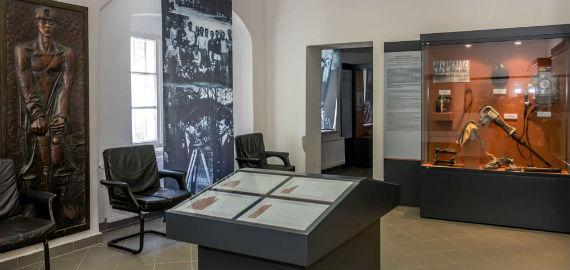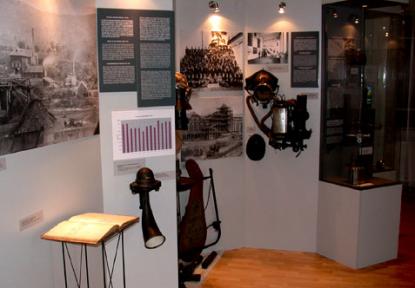2024. April 26. Friday
The Mining Museum of Mecsek - Exhibition on the History of Mining and Library - Pécs
 |
Address: 7621, Pécs Káptalan u. 3.
Phone number: (30) 934-6127
E-mail: jpm@jpm.hu
Opening hours: On prior notice
Tel: +36 (30) 218-5659 |
Museum tickets, service costs:
|
Individual ticket for adults
|
700 HUF
|
|
|
Individual ticket for students
|
350 HUF
|
|
|
Individual ticket for pensioners
|
350 HUF
|
In Mecsek and Pécs the hard coal mining started at the turn of the 18th and 19th century. Documents mentioning the occurance of coal are known since 1701. In 1769 was delivered the first report about the coal of Pécs to the Chamber of Court after the warning of Queen Mária Terézia. In 1782 began the industrial coal-mining in the coal-filed of Vasas, in the Lámpás Valley. We can talk about modern mining in coal-basin of Pécs from 1852 since the funds of companies of the first period were meager.

At this time started coal-mining the First Danube Steamship Navigation Company (FDSNC) and continued until 1945. By the turn of the 20th century the company built its 'Mining Empire' by buying and leasing estates. FDSNC was economically determinant factor in the life of Pécs, and especially in the lifes of its employees.
After 1945 in the period of state-owned coal-mining the most significant enterprise was the development of mining in Komló, besides the increasing of exploitation and the continuous technical improvement. In 1991 the economical changes led to the liquidation of Coal Mines of Mecsek enterprise. Until the beginning of 2000s coal-mining continued at Komló and Surface-Mining Company which belonged to Pécs Thermal Station Corporation. The revived exhibition embraces the events of the 250-year-old coal-mining, adverting also to the uranium-mining in the building of the Pécs' Mining Station (József Attila Street, Nr 5.)
The geological environment of coal-mining is represented by a petrified tree-trunk in the guest-hall, the specimen rock of foliated-coal with the footprints of the paleo-lizard, the shoulder-blade of a mammoth front in the main hall, and coal and other specimen-rocks. The exhibition continues with the tools and lining instruments of the first period of coal-mining and with the patinated badge of FDSNC. Because of the presence of hazardous methane in the mines of Mecsek mine-rescuing and explosion-proof personal light had a very important role from the last quarter of 19th century. The usage of modern energie sources helped to increase exploitation, which had a political consequence in the beginning of 1950s.
A typical collection of films from the '50s and '60s is on screen during the exhibition. FDSNC supported its employees, assisted their lifes "from cradle to the grave". The Company supported also their cultural and sport activities, their traditionalism, which is confirmed by nice-looking sport-trophies, the St. Borbála Statue (porcelain made in Zsolna) and mining-uniforms. On the right in the library hall is on display the St Borbála banner of FDSNC, which was consecrated in 1866. The books, journals and documents of the library have a historical value and are all on view in the library. The exhibition is closed down by Miners, a painting of Brenner Nándor.
The underground (Pécs, Káptalan Street, Nr. 3) and the uranium-mining (Kővágószőlős, Rákóczi Street, Nr. 54.) exhibitions of Mecsek Mining Museum give a great addition to the experience and information provided by this exhibition.

At this time started coal-mining the First Danube Steamship Navigation Company (FDSNC) and continued until 1945. By the turn of the 20th century the company built its 'Mining Empire' by buying and leasing estates. FDSNC was economically determinant factor in the life of Pécs, and especially in the lifes of its employees.
After 1945 in the period of state-owned coal-mining the most significant enterprise was the development of mining in Komló, besides the increasing of exploitation and the continuous technical improvement. In 1991 the economical changes led to the liquidation of Coal Mines of Mecsek enterprise. Until the beginning of 2000s coal-mining continued at Komló and Surface-Mining Company which belonged to Pécs Thermal Station Corporation. The revived exhibition embraces the events of the 250-year-old coal-mining, adverting also to the uranium-mining in the building of the Pécs' Mining Station (József Attila Street, Nr 5.)
The geological environment of coal-mining is represented by a petrified tree-trunk in the guest-hall, the specimen rock of foliated-coal with the footprints of the paleo-lizard, the shoulder-blade of a mammoth front in the main hall, and coal and other specimen-rocks. The exhibition continues with the tools and lining instruments of the first period of coal-mining and with the patinated badge of FDSNC. Because of the presence of hazardous methane in the mines of Mecsek mine-rescuing and explosion-proof personal light had a very important role from the last quarter of 19th century. The usage of modern energie sources helped to increase exploitation, which had a political consequence in the beginning of 1950s.
A typical collection of films from the '50s and '60s is on screen during the exhibition. FDSNC supported its employees, assisted their lifes "from cradle to the grave". The Company supported also their cultural and sport activities, their traditionalism, which is confirmed by nice-looking sport-trophies, the St. Borbála Statue (porcelain made in Zsolna) and mining-uniforms. On the right in the library hall is on display the St Borbála banner of FDSNC, which was consecrated in 1866. The books, journals and documents of the library have a historical value and are all on view in the library. The exhibition is closed down by Miners, a painting of Brenner Nándor.
The underground (Pécs, Káptalan Street, Nr. 3) and the uranium-mining (Kővágószőlős, Rákóczi Street, Nr. 54.) exhibitions of Mecsek Mining Museum give a great addition to the experience and information provided by this exhibition.
